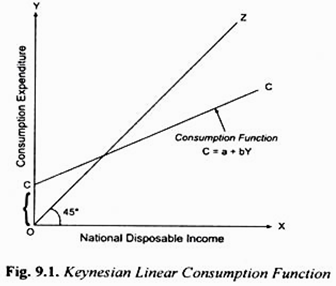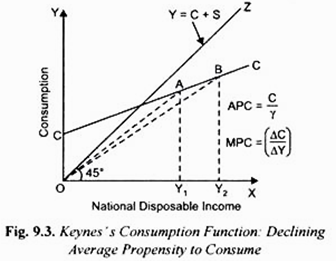Keynes’s Psychological Law of Consumption:
Further, Keynes put forward a psychological law of consumption, according to which, as income increases consumption increases but not by as much as the increase in income.
In other words, marginal propensity to consume is less than one.
1 > ∆C/∆Y > 0
While Keynes recognized that many subjective and objective factors including interest rate and wealth influenced the level of consumption expenditure, he emphasized that it is the current level of income on which the consumption spending of an individual and the society depends.
ADVERTISEMENTS:
To quote him:
“The amount of aggregate consumption depends mainly on the amount of aggregate income. The fundamental psychological law, upon which we are entitled to depend with great confidence both a priori from our knowledge of human nature and from the detailed facts of experience is that men (and women, too) are disposed, as a rule and on an average to increase their consumption as their income increases, but not by as much as the increase in their income”
In the above statement about consumption behaviour, Keynes makes three points. First, he suggests that consumption expenditure depends mainly on absolute income of the current period, that is, consumption is a positive function of the absolute level of current income. The more income in a period one has, the more is likely to be his consumption expenditure in that period.
In other words in any period the rich people tend to consume more than the poor people do. Secondly, Keynes points out that consumption expenditure does not have a proportional relationship with income. According to him, as the income increases, a smaller proportion of income is consumed. The proportion of consumption to income is called average propensity to consume (APC). Thus, Keynes argues that average propensity to consume (APC) falls as income increases.
ADVERTISEMENTS:
The Keynes’ consumption function can be expressed in the following form:
C = a + bYd
where C is consumption expenditure and Yd is the real disposable income which equals gross national income minus taxes, a and b are constants, where a is the intercept term, that is, the amount of consumption expenditure at zero level of income. Thus, a is autonomous consumption. The parameter b is the marginal propensity to consume (MPC) which measures the increase in consumption spending in response to per unit increase in disposable income. Thus
MPC = ∆C/∆Y
ADVERTISEMENTS:
It is evident from Fig. 9.1 and 9.3 the behaviour of consumption expenditure as perceived by Keynes implies that marginal propensity to consume (MPC) which is measured by the slope of consumption function curve CC at a point is less than average propensity to consume (APC) which is measured by the slope of the line joining a point on the consumption function curve CC to the origin (that is, MPC < APC).
This is because as income rises consumption does not increase proportionately and as income falls consumption does not fall proportionately as people seek to protect their earlier consumption standards. This can be seen from Fig. 9.3 the slope of consumption function curve CC’ measuring MPC and the slopes of lines OA and OB which give the APC(i. e C/Y ) at points A and B respectively are falling whereas slope of the linear consumption function CC’ remains constant.
In Fig. 9.3 we have shown a linear consumption function with an intercept term. In this form of linear consumption function, though marginal propensity to consume (AC/AF) is constant, average propensity to consume (C/F) is declining with the increase in income as indicated by the slopes of the lines OA and OB at levels of income F, and F2 respectively.
The straight line OB drawn from the origin indicating average propensity to consume at higher income level F2 has a relatively less slope than the straight line OA drawn from the origin to point/t at lower income level Fr The decline in average propensity to consume as the income increases implies that the proportion of income that is saved increases with the increase in national income of the country.
This result also follows from the studies of family budgets of various families at different income levels. The fraction of income spent on consumption by the rich families is lower than that of the poor families. In other words, the rich families save a higher proportion of their income as compared to the poor families.
The assumption of diminishing average propensity to consume is a significant part of Keynesian theory of income and employment. This implies that as income increases, a progressively larger proportion of national income would be saved. Therefore, to achieve and maintain equilibrium at full-employment level of income, increasing proportion of national income is needed to be invested.
If sufficient investment opportunities are not available, the economy would then run into trouble and in that case it would not be possible to maintain full-employment because aggregate demand will fall short of full-employment output.
ADVERTISEMENTS:
On the basis of this increasing proportion of saving with the increase in income and, consequently, the emergence of the problem of demand deficiency, some Keynesian economists based the theory of secular stagnation on the declining propensity to consume.

